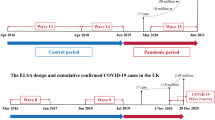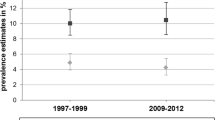Abstract
Background
Women have a higher prevalence of major depressive episodes (MDE) than men, and the annual prevalence of MDE declines with age. Age by sex interactions may occur (a weakening of the sex effect with age), but are easily overlooked since individual studies lack statistical power to detect interactions. The objective of this study was to evaluate age by sex interactions in MDE prevalence.
Methods
In Canada, a series of 10 national surveys conducted between 1996 and 2013 assessed MDE prevalence in respondents over the age of 14. Treating age as a continuous variable, binomial and linear regression was used to model age by sex interactions in each survey. To increase power, the survey-specific interaction coefficients were then pooled using meta-analytic methods.
Results
The estimated interaction terms were homogeneous. In the binomial regression model I 2 was 31.2 % and was not statistically significant (Q statistic = 13.1, df = 9, p = 0.159). The pooled estimate (−0.004) was significant (z = 3.13, p = 0.002), indicating that the effect of sex became weaker with increasing age. This resulted in near disappearance of the sex difference in the 75+ age group. This finding was also supported by an examination of age- and sex-specific estimates pooled across the surveys.
Conclusions
The association of MDE prevalence with sex becomes weaker with age. The interaction may reflect biological effect modification. Investigators should test for, and consider inclusion of age by sex interactions in epidemiological analyses of MDE prevalence.



Similar content being viewed by others
References
Alonso J, Angermeyer MC, Bernert S, Bruffaerts R, Brugha TS, Bryson H, Girolamo G, Graaf R, Demyttenaere K, Gasquet I, Haro JM, Katz SJ, Kessler RC, Kovess V, Lepine JP, Ormel J, Polidori G, Russo LJ, Vilagut G, Almansa J, Arbabzadeh-Bouchez S, Autonell J, Bernal M, Buist-Bouwman MA, Codony M, Domingo-Salvany A, Ferrer M, Joo SS, Martinez-Alonso M, Matschinger H, Mazzi F, Morgan Z, Morosini P, Palacin C, Romera B, Taub N, Vollebergh WA (2004) Prevalence of mental disorders in Europe: results from the European Study of the Epidemiology of Mental Disorders (ESEMeD) project. Acta Psychiatrica Scandinavica Supplementum 420:21–27
Blazer DG, Kessler RC, McGonagle KA, Swartz MS (1994) The prevalence and distribution of major depression in a national community sample: the National Comorbidity Survey. Am J Psychiatry 151:979–986
Kessler RC, Berglund P, Demler O, Jin R, Koretz D, Merikangas KR, Rush AJ, Walters EE, Wang PS, National Comorbidity SR (2003) The epidemiology of major depressive disorder: results from the National Comorbidity Survey Replication (NCS-R). JAMA 289:3095–3105
Patten SB, Wang JL, Williams JV, Currie S, Beck CA, Maxwell CJ, El-Guebaly N (2006) Descriptive epidemiology of major depression in Canada. Can J Psychiatry 51:84–90
Wade DT, Cairney J, Pevalin DJ (2002) Emergence of gender differences in depression during adolescence: National panel results from three countries. J Am Acad Child Adolesc Psychiatry 41:190–198
Bebbington PE, Dunn G, Jenkins R, Lewis G, Brugha LT, Farrell M, Meltzer H (1998) The influence of age and sex on the prevalence of depressive conditions: report from the National Survey of Psychiatric Morbidity. Psychol Med 28:9–19
Cairney J, Wade TJ (2002) The influence of age on gender differences in depression. Further population-based evidence on the relationship between menopause and the sex difference in depression. Soc Psychiatry Psychiatr Epidemiol 37:401–408
Faravelli C, Scarpato MA, Castellini G, Lo Sauro C (2013) Gender differences in depression and anxiety: the role of age. Psychiatry Res 210:1301–1303
Bromet E, Andrade LH, Hwang I, Sampson NA, Alonso J, de Girolamo G, de Graaf R, Demyttenaere K, Hu C, Iwata N, Karam AN, Kaur J, Kostyuchenko S, Lepine JP, Levinson D, Matschinger H, Mora ME, Browne MO, Posada-Villa J, Viana MC, Williams DR, Kessler RC (2011) Cross-national epidemiology of DSM-IV major depressive episode. BMC Med 9:90
Anonymous. (2013) National Population Health Survey-Household Component-Cross-sectional (NPHS). http://www23.statcan.gc.ca/imdb/p2SV.pl?Function=getSurvey&SDDS=3236&lang=en&db=imdb&adm=8&dis=2. Accessed 30 Dec 2013
Anonymous (2011) Canadian Community Health Survey - Annual Component (CCHS). http://www.statcan.gc.ca/cgi-bin/imdb/p2SV.pl?Function=getSurvey&SDDS=3226&lang=en&db=imdb&adm=8&dis=2. Statistics Canada. Accessed 24 Apr 2015
Gravel R, Béland Y (2005) The Canadian Community Health Survey: mental Health and Wellbeing. Can J Psychiatry 50:573–579
Anonymous. (2013) Canadian community health survey—mental health (CCHS). http://www23.statcan.gc.ca:81/imdb/p2SV.pl?Function=getSurvey&SDDS=5015&lang=en&db=imdb&adm=8&dis=2. Statistics Canada. Accessed 24 Apr 2015
Kessler RC, Andrews G, Mroczek D, Ustun B, Wittchen HU (1998) The World health organization composite international diagnostic interview short-form (CIDI-SF). Int J Methods Psychiatr Res 7:171–185
Kessler RC, Ustun TB (2004) The World Mental Health (WMH) survey initiative version of the world health organization (WHO) Composite International Diagnostic Interview (CIDI). Int J Methods Psychiatr Res 13:83–121
Thomas D, Radji S, Benedetti A (2014) Systematic review of methods for individual patient data meta- analysis with binary outcomes. BMC Med Res Methodol 14:79
Thomas S, Wannell B (2009) Combining cycles of the Canadian community health survey. Health Rep 20:53–58
Anonymous. (2014) TCPS 2—2nd edition of Tri-Council Policy Statement: ethical conduct for research involving humans. http://www.pre.ethics.gc.ca/eng/policy-politique/initiatives/tcps2-eptc2/Default/. Panel on Research Ethics. Accessed 24 Apr 2015
Vanderweele TJ, Robins JM (2007) The identification of synergism in the sufficient-component-cause framework. Epidemiology 18:329–339
Murphy JM, Laird NM, Monson RR, Sobol AM, Leighton AH (2000) A 40-year perspective on the prevalence of depression. Arch Gen Psychiatry 57:209–215
Acknowledgments
The estimates reported in this paper derive used data collected by Statistics Canada, but the analysis and results are the sole responsibility of the authors and do not reflect the views of Statistics Canada. This work was supported by an operating grant from the Canadian Institutes of Health Research (MOP-130415) and by the Hotchkiss Brain Institute. Dr. Patten is a Senior Health Scholar with Alberta Innovates, Health Solutions.
Author information
Authors and Affiliations
Corresponding author
Rights and permissions
About this article
Cite this article
Patten, S.B., Williams, J.V.A., Lavorato, D.H. et al. The association between major depression prevalence and sex becomes weaker with age. Soc Psychiatry Psychiatr Epidemiol 51, 203–210 (2016). https://doi.org/10.1007/s00127-015-1166-3
Received:
Accepted:
Published:
Issue Date:
DOI: https://doi.org/10.1007/s00127-015-1166-3




